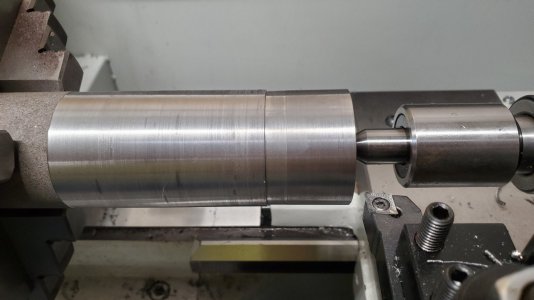- Joined
- Oct 7, 2020
- Messages
- 2,366
Not sure the title explains it well. Here's the deal, I have been playing on the lathe today with a piece of 2" diameter mystery metal and noticed that if taking a light cut of .002 it matches the DRO setting. So, I have about four inches turned down to 1.914 and about an inch turned down to 1.866. Now I setup to take a .002 cut off of the 1.866 and continued on for about 1/2" onto the 1.914 section.
So, on the .002 cut I got what I thought and ended up at 1.864 but as soon as it started cutting the 1.914 section it should have been a .050 cut but ended up being .054 cut ending up at 1.860.
I have a theory, but I thought I would ask here to see what you guys with the experience have to say.
My thought is that when the cutter starts taking the .050 cut something in the tool post, cross slide or compound is flexing causing the cutter to cut deeper.
Maybe I have too much stick out on the cutter? Maybe the gibs are too loose? Maybe that is just the way it is? Maybe all I would need is to lock the compound if I could? (I have the compound lock covered up with a DRO scale). I'm going to fix that, but that is a different story.
By the way my setup is PM-1236T, BXA quick change tool post, 5/8″ Shank Left Hand Turning Tool with a cutter designed for aluminum. I don't know what RPM I was running at (Tach is not hooked up yet) and I don't know what my feet rate was, but it was pretty slow.
I hope that all makes since.
Tim
So, on the .002 cut I got what I thought and ended up at 1.864 but as soon as it started cutting the 1.914 section it should have been a .050 cut but ended up being .054 cut ending up at 1.860.
I have a theory, but I thought I would ask here to see what you guys with the experience have to say.
My thought is that when the cutter starts taking the .050 cut something in the tool post, cross slide or compound is flexing causing the cutter to cut deeper.
Maybe I have too much stick out on the cutter? Maybe the gibs are too loose? Maybe that is just the way it is? Maybe all I would need is to lock the compound if I could? (I have the compound lock covered up with a DRO scale). I'm going to fix that, but that is a different story.
By the way my setup is PM-1236T, BXA quick change tool post, 5/8″ Shank Left Hand Turning Tool with a cutter designed for aluminum. I don't know what RPM I was running at (Tach is not hooked up yet) and I don't know what my feet rate was, but it was pretty slow.
I hope that all makes since.
Tim
Last edited:


